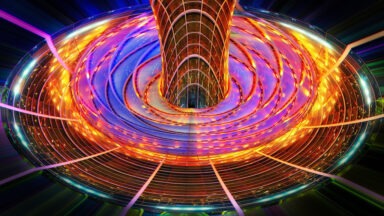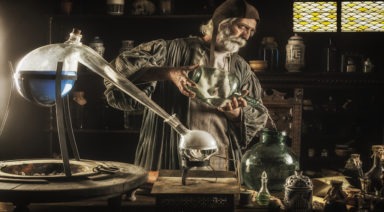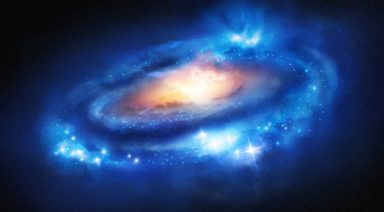Who Was The Mysterious Ed Leedskalnin, Creator of the Coral Castle?

When one thinks of iconic 20th century pioneers in the fields of engineering and electromagnetism, the genius of Nikola Tesla usually comes to mind. But rarely is the name Ed Leedskalnin mentioned; a man who single-handedly constructed one of the most fascinating monoliths – the Coral Castle – claiming he implemented secrets used by the Ancient Egyptians’ to build the pyramids.
Leedskalnin’s story is a strange one, and he did his best to maintain a mysterious legacy through cryptic messages, symbols, and hints in his work. And it all began when he immigrated to the United States from Riga, Latvia at the age of 26, heartbroken his teenage bride-to-be Agnes Scuff, left him the day they were to be married.
Upon moving to the U.S., Leedskalnin suffered from tuberculosis and was told he had mere months to live, until the kindness of a local doctor led to his full recovery. Revitalized, he bought a plot of land in Florida City for $12 – a 4,000 ft.-thick bed of coral limestone under a thin layer of topsoil – and began construction on a project he called “Rock Gate Park.” It was given this name due to the 9-ton slab of stone at its gate, which was engineered so that a child could push it open.
Leedskalnin eventually moved the Coral Castle to Homestead, FL where it remains to this day. When he moved it he hired a truck and a driver, but somehow loaded the slabs onto the truckbed alone, under the cover of night, reconstructing them by himself in their current location.
Leedskalnin stood a mere five-feet-tall and weighed barely over 100 pounds.
How Was the Coral Castle Built?
Leedskalnin had a fascination with magnetism and developed an interesting worldview based around it. In addition to creating Coral Castle, he published several pamphlets outlining a universal theory of electromagnetism and how it pertained to life on Earth. He believed nearly every function of life could be reduced to the interaction between Earth’s north and south poles, and tiny magnets contained in our bodies and every organism on Earth.
This led many to speculate that Leedskalnin used some type of magnetic levitation or resonance to lift the incredibly dense coral rock while constructing his park, though the topic has been highly debated.
While many point to images showing Leedskalnin’s use of simple pulleys and levers, others remain skeptical. He maintained that he had a strong understanding of the laws of weight and leverage, though it’s difficult to imagine him – the lean specimen he was – hoisting 30-ton blocks 20 feet in the air, entirely unassisted.
“I have discovered the secrets of the pyramids, and have found out how the Egyptians and the ancient builders in Peru, Yucatan, and Asia, with only primitive tools, raised and set in place blocks of stone weighing many tons!” –Ed Leedskalnin
Long after his death, the 9-ton gate at the entrance to Coral Castle stopped rotating as easily as it once did. To fix it, a 20-ton crane was brought in to remove, inspect, and repair it to working order. It quickly became apparent that Leedskalnin had drilled a perfectly round hole through the center of the slab without the use of power tools, fixing a metal pole between two truck bearings.
Adding to the mystery are the myriad remnants of an electromagnetic device in a chamber beneath the Coral Castle. There, one finds wires wrapped around bottles and odd devices with magnets and chains, appearing to resemble a generator of some sort. Next to the generator are two long metal poles reaching down beneath the ground, similar to the anode and cathode of a battery.
In the middle of the device is a flywheel made of concrete and magnets and shaped like a four-leaf clover. Many believe this was a perpetual motion device, based on claims from Leedskalnin’s pamphlet Magnetic Currents. When one holds a compass to the device and cranks it, the compass needle spins, indicating the magnets are set opposite in polarity.
Other features of the castle show that Leedskalnin had a strong grasp on astronomy. For example, the Polaris “telescope” built of coral rock aligns itself with the eponymous star through crosshairs constructed from metal wire. Though the “telescope” is simply a hole drilled through rock, it’s alignment is precise, adding itself to sundials and other primitive forms of celestial measurement devices Leedskalnin designed with utmost precision.
Pictures of Coral Castle

Carvings sit on top of a wall on the Coral Castle in tropical Florida

Carved rock telescope at Coral Castle in Florida

Garden landscaping at Coral Castle, Florida

Table and chair carved out of coral

Ed Leedskalnin’s electromagnetic device
The Coral Castle has captivated the minds of many, including famous rockstar Billy Idol, whose song “Sweet Sixteen” found its muse in Leedskalnin’s story or love and heartbreak. Idol wrote the song after watching an episode of Leonard Nemoy’s series, “In Search of…” recounting the story of the man behind the Coral Castle.
Leedskalnin’s secrets in constructing the Coral Castle may forever remain a secret unless someone with enough interest and affinity for the strange world of forbidden science and electromagnetism can decode his cyphered clues. For now, the Castle remains a tourist destination in Florida, open for anyone to marvel at his wondrous creation.
When Leedskalnin spoke of tiny magnets in the human body could he have been referencing magnetite? Watch this short below:
The Mystery of Torsion Fields

Russian scientist Nikolai Kozyrev was considered a prodigy. In 1925, at age 17, he published his first scientific paper, which focused on astrophysics and the atmosphere of the sun and other stars. It was met with great acclaim by other scientists.
At age 20, he graduated from the University of Leningrad with degrees in physics and mathematics. By age 28, he was a college professor and distinguished astronomer. To the science community at large, this promising young physicist disappeared for the next 11 years.
Nikolai Kozyrev: Russian Concentration Camps
While Korzyrev was enjoying a successful career as a professor and researcher, Josef Stalin, leader of the Soviet Union, was feeling threatened by scientists whom he perceived were independent thinkers. He was concerned they would see through his propaganda program. To prevent this, in 1936, he arrested them and sent them to concentration camps. Nikolai Kozyrev was among those imprisoned. There wasn’t much for him to do during the long 11 years he spent in the camps except to observe, meditate, and think.
During his imprisonment, Kozyrev was enthralled watching bacteria grow and noticed it grew in a perfect spiral. This led him to conclude that all life-forms likely draw off of an unseen spiraling source of energy. This energy is as important to maintenance and growth of life as are “eating, drinking, breathing, and photosynthesis.”
Kozyrev also concluded that this spiraling energy and growth is how time works, with the Earth orbiting in space by way of a “complex spiraling pattern.”
As the Earth rotates on its axis as it orbits the sun, it releases energy, or torsion waves, that propel it through space. The torsion waves travel at speeds faster than the speed of light. These torsion fields are actually “waves of time” which also cause ripples in gravity. Indeed, some scientists now believe that “electromagnetism, gravity and torsion waves are all members of the same family; they are just different forms of ether vibrations.”




































